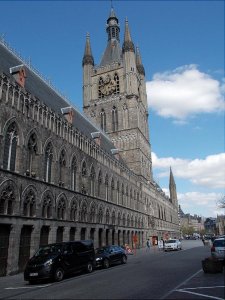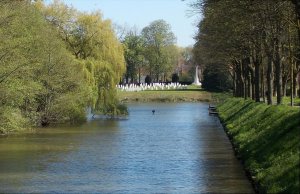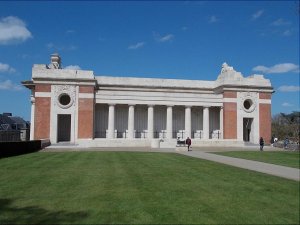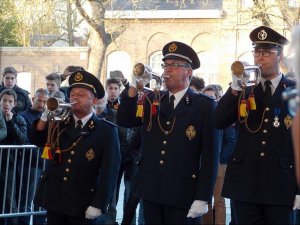Capt Lightning
Well-known Member
- Location
- Historic Buchan, Scotland
This was the last European stop on our trip before returning to the UK. I've written a bit more about this, so I
hope you find it interesting.

The Cloth Hall is a series of buildings surrounding a rectangular courtyard.
The building work was started in 1200 and took over 100 years to complete, being finished in 1304.
Until the mid 1840s the small Ieperlee river flowed through the town and past the western end of the Hall and
small boats could make their way right up to the Cloth Hall from the Yser Canal.
The belfry was the oldest part of the hall. The foundation stone was laid in 1201 The bell tower was originally a watchtower to keep a lookout for invaders or fire. The tower contained bells to warn the inhabitants of danger.
The belfry now contains 49 bells in a carillon and performances are given on special days of the year, such as Armistice Day on 11th November.
The first damage to the the Cloth Hall and the Belfry occurred during the First Battle of Ypres
in November 1914. The British defence was holding east of the city of Ypres and the German Army was not going to be able to capture Ypres. The German army then started a long range bombardment of the city.
On 22nd November, German incendiary devices hit the Cloth Hall and it was set on fire.
A few months later, Ypres began to be shelled by long range German heavy howitzers . This was to draw Allied
attention away from secret trials by the German Army of a new weapon - poisonous gas.
And so, the Germans began a systematic demolition of the medieval city.
All the unique works of art in the upper halls were destroyed.
The buildings making up the complex of the Cloth Hall were completely destroyed by 1918.
Only a small part of the belfry tower walls remained standing, becoming an iconic image of the devastated city.
Reconstruction of the Cloth Hall was started in 1926 and not completed till 1967.
The belfry tower of Ypres is now a World Heritage Site.
Today the Cloth Hall houses the "Flanders Fields" museum. This is, in my mind, one of the great museums of Europe.
It does not seek to shock or glamourise Ypres' part in the great war. The words 'moving', 'humbling' and
'emotional' are frequently used to describe it. It is also sometimes an uncomfortable experience as the futilities and horrors of war are explained. This, along with the 'Memin Gate' is a "must see" if you visit Ypres.
Within the city ramparts are two small war cemetaries, maintained by the War Graves Commission.

And now we come to the Menin Gate.

This 'Memorial to the Missing' is dedicated to the British and Commonwealth soldiers who were killed in the Ypres Salient of WW1 and who have no known grave. Estimates vary, but between half a million and one million men (of all sides) are thought to have died in 1914-1918 in action round Ypres .
The walls are inscribed with 54,896 names whose graves are unknown - carved on stone tablets and arranged by regiment.
Although my grandfather did not take part in action at Ypres, his regiment, "The Cameronians" is remembered on panel 22. On the memorial roof, there are circular openings, and when the sun moves across the sky, it illuminates the panels like spotlights.

The Last Post
Every evening at 8 o'clock, in all weathers, buglers play the Last Post at the Menin Gate Memorial.
This was started in 1927 and it has been played every night since except for a period in the
Second World War when Ypres was occupied by German Forces. During this period, the ceremony
was performed in England. On the day in September 1944 that Ypres was liberated by Polish forces, in spite of continuing gunfire, the Last Post was sounded again.

Following the Last Post, is the Oration - taken from Laurence Binyon's poem, "For the Fallen".
They shall grow not old, as we that are left grow old:
Age shall not weary them, nor the years condemn.
At the going down of the sun and in the morning,
We will remember them.
Often there are wreath laying ceremonies - sometimes by the armed forces,
sometimes by servicemens' associations, schools or individuals.
When you go Home, tell them of us and say,
For your Tomorrow, we gave our Today
Finally, Réveille is sounded and the ceremony ends.
Over the years that I have seen the ceremony, the number of people attending seems to have increased.
Visiting the battlefields of Europe has become a 'must' for those interested in modern history.
And so to home. I didn't take any photos over the next few days when we travelled through England.
I hope you have enjoyed my traveller's tale.
hope you find it interesting.

The Cloth Hall is a series of buildings surrounding a rectangular courtyard.
The building work was started in 1200 and took over 100 years to complete, being finished in 1304.
Until the mid 1840s the small Ieperlee river flowed through the town and past the western end of the Hall and
small boats could make their way right up to the Cloth Hall from the Yser Canal.
The belfry was the oldest part of the hall. The foundation stone was laid in 1201 The bell tower was originally a watchtower to keep a lookout for invaders or fire. The tower contained bells to warn the inhabitants of danger.
The belfry now contains 49 bells in a carillon and performances are given on special days of the year, such as Armistice Day on 11th November.
The first damage to the the Cloth Hall and the Belfry occurred during the First Battle of Ypres
in November 1914. The British defence was holding east of the city of Ypres and the German Army was not going to be able to capture Ypres. The German army then started a long range bombardment of the city.
On 22nd November, German incendiary devices hit the Cloth Hall and it was set on fire.
A few months later, Ypres began to be shelled by long range German heavy howitzers . This was to draw Allied
attention away from secret trials by the German Army of a new weapon - poisonous gas.
And so, the Germans began a systematic demolition of the medieval city.
All the unique works of art in the upper halls were destroyed.
The buildings making up the complex of the Cloth Hall were completely destroyed by 1918.
Only a small part of the belfry tower walls remained standing, becoming an iconic image of the devastated city.
Reconstruction of the Cloth Hall was started in 1926 and not completed till 1967.
The belfry tower of Ypres is now a World Heritage Site.
Today the Cloth Hall houses the "Flanders Fields" museum. This is, in my mind, one of the great museums of Europe.
It does not seek to shock or glamourise Ypres' part in the great war. The words 'moving', 'humbling' and
'emotional' are frequently used to describe it. It is also sometimes an uncomfortable experience as the futilities and horrors of war are explained. This, along with the 'Memin Gate' is a "must see" if you visit Ypres.
Within the city ramparts are two small war cemetaries, maintained by the War Graves Commission.

And now we come to the Menin Gate.

This 'Memorial to the Missing' is dedicated to the British and Commonwealth soldiers who were killed in the Ypres Salient of WW1 and who have no known grave. Estimates vary, but between half a million and one million men (of all sides) are thought to have died in 1914-1918 in action round Ypres .
The walls are inscribed with 54,896 names whose graves are unknown - carved on stone tablets and arranged by regiment.
Although my grandfather did not take part in action at Ypres, his regiment, "The Cameronians" is remembered on panel 22. On the memorial roof, there are circular openings, and when the sun moves across the sky, it illuminates the panels like spotlights.

The Last Post
Every evening at 8 o'clock, in all weathers, buglers play the Last Post at the Menin Gate Memorial.
This was started in 1927 and it has been played every night since except for a period in the
Second World War when Ypres was occupied by German Forces. During this period, the ceremony
was performed in England. On the day in September 1944 that Ypres was liberated by Polish forces, in spite of continuing gunfire, the Last Post was sounded again.

Following the Last Post, is the Oration - taken from Laurence Binyon's poem, "For the Fallen".
They shall grow not old, as we that are left grow old:
Age shall not weary them, nor the years condemn.
At the going down of the sun and in the morning,
We will remember them.
Often there are wreath laying ceremonies - sometimes by the armed forces,
sometimes by servicemens' associations, schools or individuals.
When you go Home, tell them of us and say,
For your Tomorrow, we gave our Today
Finally, Réveille is sounded and the ceremony ends.
Over the years that I have seen the ceremony, the number of people attending seems to have increased.
Visiting the battlefields of Europe has become a 'must' for those interested in modern history.
And so to home. I didn't take any photos over the next few days when we travelled through England.
I hope you have enjoyed my traveller's tale.

